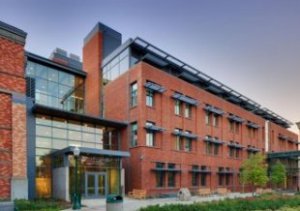Jan 6 2014
The Robert and Beverly Lewis Integrative Science Building at the University of Oregon recently became the first structure on campus and the first higher education laboratory in Oregon to be awarded Leadership in Energy and Environmental Design (LEED) Platinum certification, the highest possible certification, by the U.S. Green Building Council.
 Lewis Integrative Science Building
Lewis Integrative Science Building
"This distinction reflects the ambitious ideals of the Lewis Integrative Science Building, one of the most advanced research facilities in the world," said Kimberly Andrews Espy, UO vice president for research and innovation and dean of the graduate school. "The building encourages researchers to connect with one other from across different disciplines, and the combination of usability and sustainability sets the stage for the future of research and innovation at the University of Oregon."
Opened in October 2012 as part of the UO’s Lorry I. Lokey Science Complex, the 103,000-square-foot Lewis building is the home of biologists, chemists, neuroscientists, psychologists and other researchers, bringing together world-class researchers under one roof from a range of disciplines.
“The planning for the new Lewis Integrative Science Building was conceived to create the opportunity for high levels of faculty and student interaction,” said Charles Cassell, principal of HDR Inc., one of the architectural teams for the project.
The platinum certification is especially rare for a laboratory building type, which includes energy-intensive wet labs for biologists and chemists. Only nine education buildings in Oregon have achieved this certification, and only 12 percent – approximately 1,100 – of all LEED-certified buildings worldwide have reached platinum status.
“It is common for such projects to use six to eight times the energy of a conventional office building,” said Mitch Dec, the project’s energy analyst from GLUMAC Engineering.
As part of the LEED certification process, building projects earn points to satisfy green building requirements. The major credit categories include sustainable sites, water efficiency, energy and atmosphere, materials and resources, and indoor environmental quality.
“LEED Platinum would not have been possible without the leadership and support of the university’s user group committee for the project, which understood its value in supporting their mission,” said Laurie Canup, project architect with THA Architecture. “We are so proud to have been a part of the close collaborative team that made this project such a huge success.”
The ambitious goals of the Lewis Building are reflected in its forward-thinking design. The building makes abundant use of natural light and the open layout of the labs and spaces enables science to be a collaborative process. An unheated glass atrium with stadium seating provides a place for faculty and students to congregate, while maximizing daylight and allowing light to penetrate into adjacent labs.
The Lewis building uses 62 percent less energy than similar conventionally designed buildings, and approximately 17 percent of the energy savings comes from the building’s reuse of waste heat that is used to control the temperature in the labs and offices.
“The heat recovery system took advantage of the wasted heat energy within the adjacent utility tunnels. The hot air was run through three air-to-water heat exchangers. That heated air was transferred into the building’s heating water and in turn used to heat the building,” said Mark Butler, project manager from Lease Crutcher Lewis, the project’s contractor.
Additional sustainable design strategies in the LISB include:
- Reuse of waste water from an adjacent laboratory building for flushing urinals and toilets;
- Twenty-eight rooftop solar panels for hot water supply;
- Chilled beams and radiators in offices for cooling and heating;
- Operable windows and indicator lights to let users know when they can open windows;
- Exterior solar shading on south-facing windows;
- Sustainably sourced building materials, such as local brick and bamboo wall panels;
- Green cleaning products and practices developed with the UO’s Green Product Design Network and graduate students in chemistry; and
- Rain gardens for collecting storm water and low-maintenance landscaping.
In 2011, the University of Oregon formally adopted the Oregon Model for Sustainable Development, part of the UO Campus Plan, and seeks to offset new construction energy use from development and renovation on its 295-acre campus. New projects are required to be a minimum of LEED Gold certified and to produce 35 percent greater energy savings than the state’s building code requires.
The $65 million project was made possible through State of Oregon general bonds and donations from Robert and Beverly Lewis, Lorry I. Lokey, William Swindells, the James R. Kuse Family Foundation and Rosaria Haugland. The design and construction process for the Lewis building was led by UO Campus Planning and Real Estate, UO Capital Construction, HDR Inc., THA Architecture and Lease Crutcher Lewis.
About the University of Oregon
The University of Oregon is among the 108 institutions chosen from 4,633 U.S. universities for top-tier designation of "Very High Research Activity" in the 2010 Carnegie Classification of Institutions of Higher Education. The UO is also one of two Pacific Northwest members of the Association of American Universities.
MEDIA CONTACT: Melissa Foley, UO media relations, 541-346-5361, [email protected]
Note: The University of Oregon is equipped with an on-campus television studio with a point-of-origin Vyvx connection, which provides broadcast-quality video to networks worldwide via fiber optic network. In addition, there is video access to satellite uplink, and audio access to an ISDN codec for broadcast-quality radio interviews.